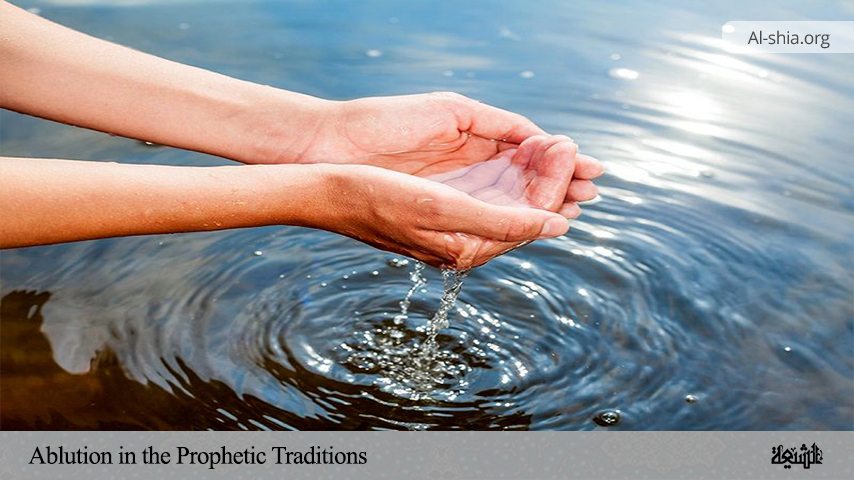Some people have claimed that traditions imply the cof washing the feet in the ritual ablution and that there are no valid traditions for rubbing them. This claim has led them to justify and interpret the honourable verse of ablution against its apparent meaning.
The counter-argument to this claim is that so many valid traditions stipulate the obligation of rubbing, not washing the feet.
The readers’ attention is hereinafter directed to some traditions narrated by the Sunnis: It is narrated from Rifa’ah Ibn Rafi’ that he was by the Prophet (a.s) when said: “In fact, no one’s prayer is acceptable until he/she accomplishes the ablution completely and correctly, as the Almighty has stated, i.e. washes the face and the hands to the elbows and rub the head and the feet to the ankles” (1).
As is evident, this tradition has clearly stated that the head and the feet should be rubbed. Al-Bukhari, Ahmad, Ibn Abi Shaybah, Ibn Abi Umar, Al-Baghawi, Al-Tabarani, Al-Bawirdi and others have narrated Abbad Ibn Tamim Al-Mazani’s reporting his father’s saying: “I saw the Messenger of Allah (a.s) performing ablution and rubbing his feet with water.” (2)
Ibn Hajar Asqalani narrated this tradition in the biography of Tamim Ibn Zayd Ansari, saying, “The narrators of the tradition are all trustworthy.” The stipulation of this tradition to the obligation of rubbing the feet is also clear.
It is narrated from Abu Matar that he said:
One noon, as I was sitting in a mosque near Bab al-Rahmah (A door in Kufah Mosque) with Amir al-Mu’minin (the Commander of the Believers) Imam Ali (a.s), a man came and asked him to show him the ablution as performed by the Messenger of Allah (a.s). Ali (a.s) called Qanbar (his servant) and asked for a jug of water.
Then, he washed his two palms and his face three times. Then he took some of his fingers to his mouth (washing his teeth) and sniffed water twice or three times. Next, he washed his forearms three times and rubbed his head once. Then he said, “Inside the mouth and the nose are like the face and their outside parts are like the head (in ablution).”
He then rubbed his feet to the ankles while water poured from his beard to his chest. Then he drank water and said, “Where is the man who asked me about the Prophet’s ablution? His ablution was like this.”
In Tahdhib Al-Tahdhib, Ibn Hajar has cited Ibn Habban and Abu Matar among the trustee. Hamran says: Uthman asked for water and performed ablution. Then he smiled and said, “Will you ask me why I smiled?” He was then asked, “Well, what made you smile?”
He replied, “I saw the Prophet (a.s) perform ablution as I have just done; he rinsed his mouth with water and sniffed it and washed his hands three times and rubbed his head and the top of his feet.” (3)
The same tradition is narrated in Kanz Al-Ummal and Abu Ya’li is quoted as saying that this tradition is true (4). Abu Malik Ash’ari told his relatives, “Come to me to copy the prayer of the Prophet (a.s).”
Then he asked for water to perform ablution. He sniffed water and washed his face three times and washed his (hands from) elbows three times, and rubbed his head and the top of his feet. Then they performed prayers (5).
The Messenger of Allah (a.s) performed ablution and rubbed on his shoes and his feet (6). It is narrated from Rubayyi’ that she said, “Ibn Abbas came to me and asked about the tradition I have narrated—the one stating that the Prophet (a.s) washed his feet in ablution. So, Ibn Abbas said, “People avoid anything but washing, while I find in Allah’s Book not but the obligation of rubbing” (7). According to Al-Zawa’id, “The document of this tradition is true.”
Muhammad Ibn Jarir Tabari, in his Tafsir (exegesis of the Holy Qur`an), quotes Ibn Abbas as saying: Ablution contains two washings (the face and the hands) and two rubbings (head and the feet)” (8). Ibn Jarir Tabari writes in his Tafsir again (9).
Humayd Tuwayl says: Musa, son of Anas, told his father, O Abu Hamza! Hajjaj delivered a sermon for us in Ahwaz; he reminded us of the ritual purity saying, ‘Wash your faces and your hands and rub your head and feet.
Indeed, nothing is dirtier in the human body than the feet, so wash your feet—both sides.’ Anas said, ‘The Almighty said the truth but Hajjaj lied. The Almighty says: Rub your head and feet.’ Humayd Tuwayl said, ‘Anas himself, when rubbing, wets his feet’ (10).
All the narrators of this tradition have been confirmed to be truthful (11) as Ibn Kathir does in his Tafsir. As you see, Anas, a Companion of the Prophet, denies a person who obliges washing the feet in the ritual ablution and believes that God has only stipulated rubbing. Abi Ja’far said: “Rub your head.” (12)
Shi’bi is quoted as saying, “The feet should only be rubbed. Do you not see that some people rub when they should wash and leave where they should rub?”(13) It is narrated that Ikramah said: “The feet should not be washed, but rubbed.”(14) There are a variety of such traditions.
In short, so many traditions have been narrated from the Holy Prophet (s.a.w.a), the Companions and their followers deem rubbing obligatory. Regarding the Holy Quran’s stipulation about the obligation of rubbing and also the many traditions some of which are true, is it accurate to issue a verdict as to the obligation of washing the feet in ablution?
If it is said that the ablution verse is downplayed by the traditions, it would be answered:
First, the ablution verse is in Al-Ma’idah Chapter, and as we mentioned before, both the Chapter and the honourable verse have been revealed in the last years of the Prophet’s life and, hence, the possibility of cancelling them is little.
Second, opposing traditions, as narrated by Fakhr Razi and others, are interrupted (15) traditions, which cannot abrogate the Holy Quran’s verses.
The ultimate solution to the problem of the traditions of washing (the feet) is to ultimately solve the contrast between the traditions stating the washing of the feet (during the ritual ablution) on one hand and the Holy Quran and the traditions stating the rubbing on the other, it is more appropriate to say that in case the traditions narrated from the Holy Prophet (s.a.w.a) denoting washing (the feet) are true, they are all from the time before the revelation of the ablution verse, and this honourable Verse and the traditions of the rubbing abrogate them.
Some people have been unaware of this fact and issued verdicts based on the cancelled traditions or believed in the option to wash or rub. Still, some others have obliged both of them.
One may say that the obligation of washing is reached by consensus, (16) which cannot be rejected. To answer, there is no such consensus. For abolishing this suspicion, a reference to Islamic jurisprudence books suffices. Bidayat Al-Hikmah, for instance, stipulates that this is a controversial issue, reading: Scholars have consensus that the feet are among the organs of ablution, but they do not agree on their kind of washing. Some say that they should be washed. These are Sunni scholars. Others say what is obligatory is to rub them. Still, others have said that washing and rubbing are allowed and are up to the individuals (17).
Also, Ibn Qudamah says, in Al-Mughni, that washing the feet (in the ablution) is compulsory for most scholars. He then reports from (Imam) Ali, Ibn Abbas, Anas and Shi’bi that rubbing them are obligatory; and he reports the option between rubbing and washing from Ibn Jabir. Nawawi, in Al-Majmu’, says: Our disciples have quoted Muhammad Ibn Jarir as believing in the option between washing and rubbing the feet.
Khattabi narrated the same concept from Al-Jaba’i, the Mu’tazilite. Some who take in the surface indications of the traditions have deemed allowable both washing and rubbing.
As you see, no such consensus exists among the Sunni scholars, let alone among the Shia, since based on what is narrated by the Shia, the Ahl al-Bayt (a.s) have consensus on the obligation of rubbing the feet in the ablution. But what is the amount of rubbing?
I only remind that some traditions, as mentioned before, read, “The Holy Prophet rubbed his head and the top of his feet.”
Also, various traditions about rubbing the shoes indicate that rubbing the feet to the ankles is enough. Moreover, the application of ‘rubbing to the ankles’ and connecting it to “رؤسكم” (your hands) in the Ablution Verse is the best proof on the sufficiency of rubbing the top of the feet to the ankles.
Extracted from the article titled “Wuzu in the Holy Qur’an and the Hadith” by Abdorahman
NOTES:
________________
1. Sunan Ibn Majah. Vol. 1, section 57, tradition 460, No. 453; Sunan Abi Dawud, No. 730; Sunan Al-Nisa’i, No. 1124; Sunan Al-Darimi 1295 (Int’l No.).
2. Al-Isaba, Vol. 1, p. 185, No. 843.
3. Musnad Abi Shaybah, Vol. 1, p. 18. Nearly the same is narrated in Musnad Ahmad, Musnad Al-Asharah, No. 391 (Int’l No.).
4. p. 442, No. 26886.
5. Musnad Ahmad Ibn Hanbal, No. 21825 (Int’l No.).
6. Sunan Abi Dawud, Vol. 1, p. 41, No. 160, No. 138 (Int’l No.).
7. Sunan Ibn Majah, Vol. 1, p. 156, No. 458, No. 451; Musnad Ahmad, No. 25773 (Int’l No.).
8. Tafsir Tabari, section 6, p. 82.
9. Tafsir Tabari, Section 2, p. 82.
10. In his book, Al-Durr Al-Manthur, Suyuti narrates this tradition under the Ablution Verse, quoted by Sa’id Ibn Mansur and Ibn Abi Shaybah.
11. See Tahdhib Al-Tahdhib.
12. Tafsir Tabari, section 6, p. 82.
13. Tafsir Tabari, section 9, p. 83.
14. Tafsir Tabari, section 6, p. 82.
15. According to the classification of traditions (hadith), they are divided into successive and interrupted. A successive tradition is that which is narrated by a variety of narrators of every age who are away from alteration and mistake. An interrupted tradition is not so.
16. What is agreed upon by all Islamic scholars.
17. Ibn Rushd, Bidayah Al-Mujtahid, Published in Egypt, Vol. 1, Kitab Al-Taharah, Kitab Al-Wuzu’, section 2, Question 10,p. 14.


















